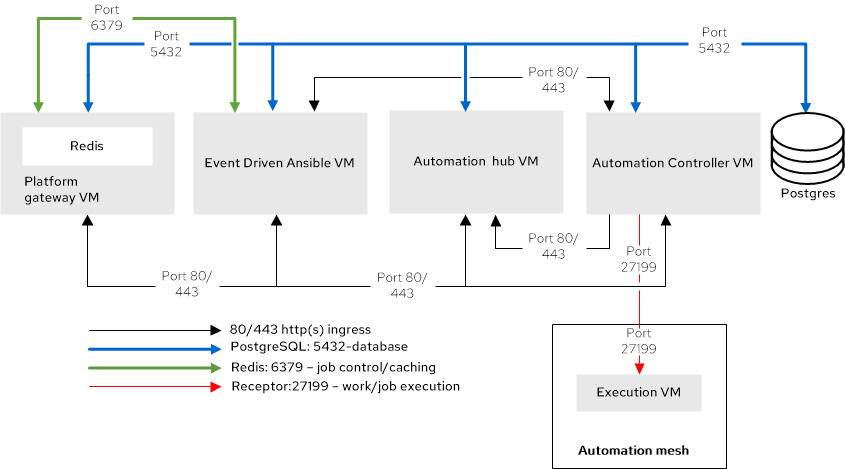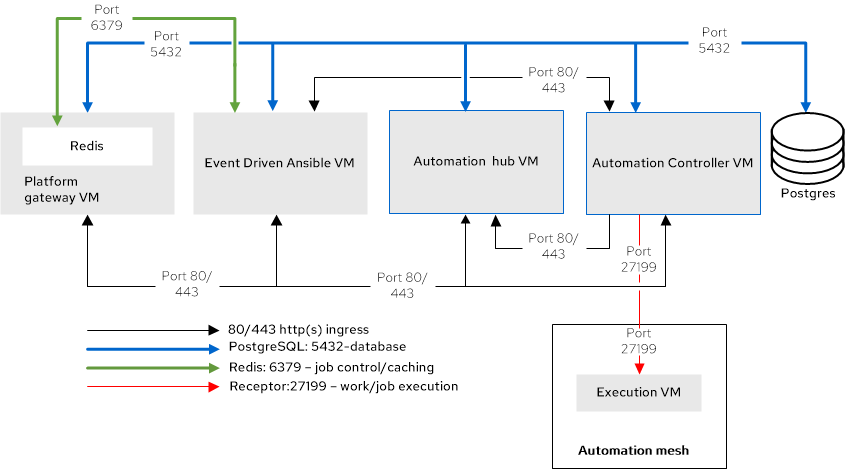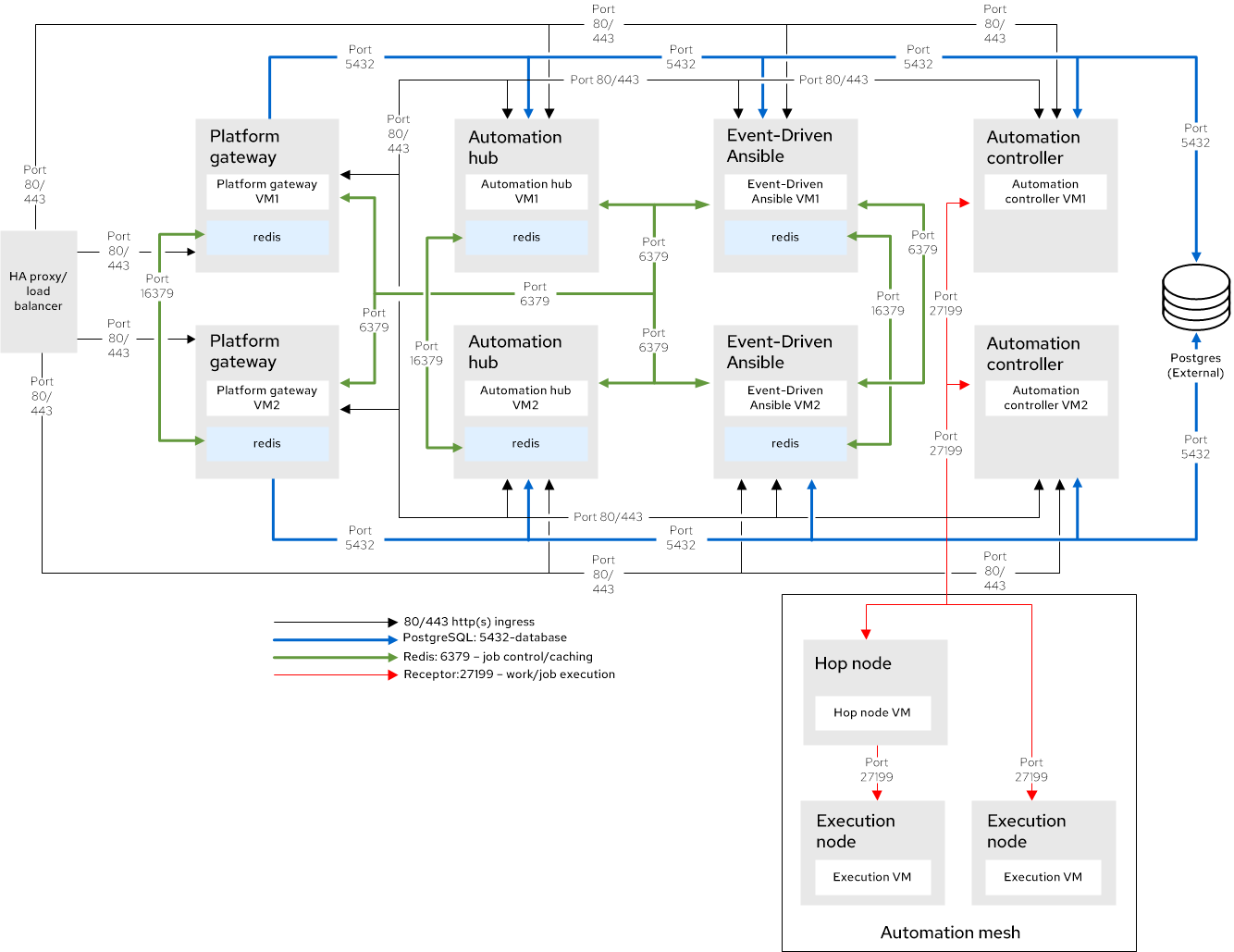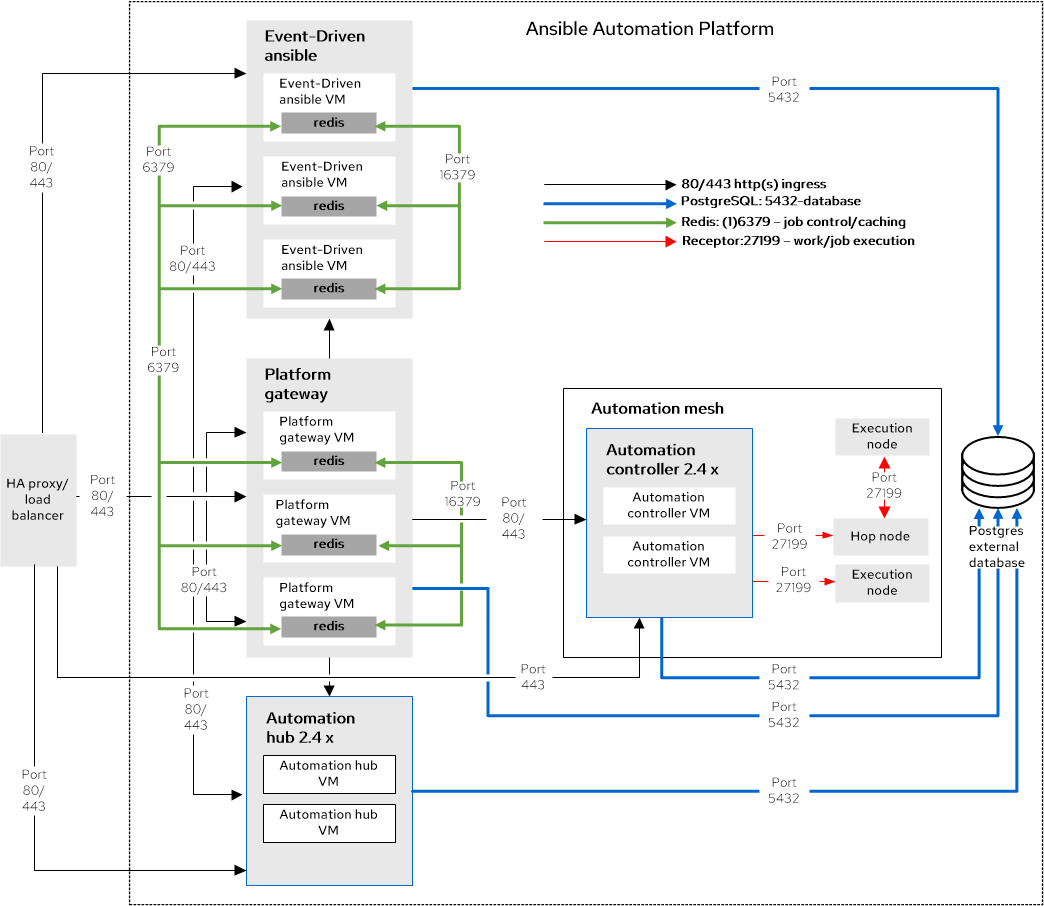Ce contenu n'est pas disponible dans la langue sélectionnée.
Chapter 2. RPM topologies
The RPM installer deploys Ansible Automation Platform on Red Hat Enterprise Linux by using RPMs to install the platform on host machines. Customers manage the product and infrastructure lifecycle.
2.1. RPM growth topology
The growth topology is intended for organizations that are getting started with Ansible Automation Platform and do not require redundancy or higher compute for large volumes of automation. This topology allows for smaller footprint deployments.
2.1.1. Infrastructure topology
The following diagram outlines the infrastructure topology that Red Hat has tested with this deployment model that customers can use when self-managing Ansible Automation Platform:
Figure 2.1. Infrastructure topology diagram

Each virtual machine (VM) has been tested with the following component requirements: 16 GB RAM, 4 CPUs, 60 GB local disk, and 3000 IOPS.
| VM count | Purpose | Example VM group names |
|---|---|---|
| 1 | Platform gateway with colocated Redis |
|
| 1 | Automation controller |
|
| 1 | Private automation hub |
|
| 1 | Event-Driven Ansible |
|
| 1 | Automation mesh execution node |
|
| 1 | Database |
|
2.1.2. Tested system configurations
Red Hat has tested the following configurations to install and run Red Hat Ansible Automation Platform:
| Type | Description |
|---|---|
| Subscription | Valid Red Hat Ansible Automation Platform subscription |
| Operating system |
|
| CPU architecture | x86_64, AArch64, s390x (IBM Z), ppc64le (IBM Power) |
| Ansible-core | Ansible-core version 2.16 or later |
| Browser | A currently supported version of Mozilla Firefox or Google Chrome |
| Database | PostgreSQL 15 |
2.1.3. Network ports
Red Hat Ansible Automation Platform uses several ports to communicate with its services. These ports must be open and available for incoming connections to the Red Hat Ansible Automation Platform server for it to work. Ensure that these ports are available and are not blocked by the server firewall.
| Port number | Protocol | Service | Source | Destination |
|---|---|---|---|---|
| 80/443 | TCP | HTTP/HTTPS | Event-Driven Ansible | Automation hub |
| 80/443 | TCP | HTTP/HTTPS | Event-Driven Ansible | Automation controller |
| 80/443 | TCP | HTTP/HTTPS | Automation controller | Automation hub |
| 80/443 | TCP | HTTP/HTTPS | Platform gateway | Automation controller |
| 80/443 | TCP | HTTP/HTTPS | Platform gateway | Automation hub |
| 80/443 | TCP | HTTP/HTTPS | Platform gateway | Event-Driven Ansible |
| 5432 | TCP | PostgreSQL | Event-Driven Ansible | Database |
| 5432 | TCP | PostgreSQL | Platform gateway | Database |
| 5432 | TCP | PostgreSQL | Automation hub | Database |
| 5432 | TCP | PostgreSQL | Automation controller | Database |
| 6379 | TCP | Redis | Event-Driven Ansible | Redis node |
| 6379 | TCP | Redis | Platform gateway | Redis node |
| 8443 | TCP | HTTPS | Platform gateway | Platform gateway |
| 27199 | TCP | Receptor | Automation controller | Execution node |
2.1.4. Example inventory file
Use the example inventory file to perform an installation for this topology:
# This is the Ansible Automation Platform installer inventory file intended for the RPM growth deployment topology. # Consult the Ansible Automation Platform product documentation about this topology's tested hardware configuration. # https://docs.redhat.com/en/documentation/red_hat_ansible_automation_platform/2.5/html/tested_deployment_models/rpm-topologies # # Consult the docs if you are unsure what to add # For all optional variables consult the Ansible Automation Platform documentation: # https://docs.redhat.com/en/documentation/red_hat_ansible_automation_platform/2.5/html/rpm_installation # This section is for your platform gateway hosts # ----------------------------------------------------- [automationgateway] gateway.example.org # This section is for your automation controller hosts # ----------------------------------------------------- [automationcontroller] controller.example.org [automationcontroller:vars] peers=execution_nodes # This section is for your Ansible Automation Platform execution hosts # ----------------------------------------------------- [execution_nodes] exec.example.org # This section is for your automation hub hosts # ----------------------------------------------------- [automationhub] hub.example.org # This section is for your Event-Driven Ansible controller hosts # ----------------------------------------------------- [automationedacontroller] eda.example.org # This section is for the Ansible Automation Platform database # ----------------------------------------------------- [database] db.example.org [all:vars] # Common variables # https://docs.redhat.com/en/documentation/red_hat_ansible_automation_platform/2.5/html/rpm_installation/appendix-inventory-files-vars#ref-general-inventory-variables # ----------------------------------------------------- registry_username=<your RHN username> registry_password=<your RHN password> redis_mode=standalone # Platform gateway # https://docs.redhat.com/en/documentation/red_hat_ansible_automation_platform/2.5/html/rpm_installation/appendix-inventory-files-vars#ref-gateway-variables # ----------------------------------------------------- automationgateway_admin_password=<set your own> automationgateway_pg_host=db.example.org automationgateway_pg_password=<set your own> # Automation controller # https://docs.redhat.com/en/documentation/red_hat_ansible_automation_platform/2.5/html/rpm_installation/appendix-inventory-files-vars#ref-controller-variables # ----------------------------------------------------- admin_password=<set your own> pg_host=db.example.org pg_password=<set your own> # Automation hub # https://docs.redhat.com/en/documentation/red_hat_ansible_automation_platform/2.5/html/rpm_installation/appendix-inventory-files-vars#ref-hub-variables # ----------------------------------------------------- automationhub_admin_password=<set your own> automationhub_pg_host=db.example.org automationhub_pg_password=<set your own> # Event-Driven Ansible controller # https://docs.redhat.com/en/documentation/red_hat_ansible_automation_platform/2.5/html/rpm_installation/appendix-inventory-files-vars#event-driven-ansible-controller # ----------------------------------------------------- automationedacontroller_admin_password=<set your own> automationedacontroller_pg_host=db.example.org automationedacontroller_pg_password=<set your own>
2.2. RPM mixed growth topology
The growth topology is intended for organizations that are getting started with Ansible Automation Platform and do not require redundancy or higher compute for large volumes of automation. This topology allows for smaller footprint deployments. The mixed topology has different versions of Ansible Automation Platform intended for configuring a new installation of Event-Driven Ansible 1.1 with automation controller 4.4 or 4.5.
2.2.1. Infrastructure topology
The following diagram outlines the infrastructure topology that Red Hat has tested with this deployment model that customers can use when self-managing Ansible Automation Platform:
Figure 2.2. Infrastructure topology diagram

Here, automation controller and automation hub are at 2.4x while the Event-Driven Ansible and platform gateway components are at 2.5
Each virtual machine (VM) has been tested with the following component requirements: 16 GB RAM, 4 CPUs, 60 GB local disk, and 3000 IOPS.
| VM count | Purpose | Ansible Automation Platform version | Example VM group names |
|---|---|---|---|
| 1 | Platform gateway with colocated Redis | 2.5 |
|
| 1 | Automation controller | 2.4 |
|
| 1 | Private automation hub | 2.4 |
|
| 1 | Event-Driven Ansible | 2.5 |
|
| 1 | Automation mesh execution node | 2.4 |
|
| 1 | Database | 2.4 |
|
2.2.2. Tested system configurations
Red Hat has tested the following configurations to install and run Red Hat Ansible Automation Platform:
| Type | Description |
|---|---|
| Subscription | Valid Red Hat Ansible Automation Platform subscription |
| Operating system |
|
| CPU architecture | x86_64, AArch64 |
| Ansible-core | Ansible-core version 2.16 or later |
| Browser | A currently supported version of Mozilla Firefox or Google Chrome |
| Database | PostgreSQL 15 |
2.2.3. Network ports
Red Hat Ansible Automation Platform uses several ports to communicate with its services. These ports must be open and available for incoming connections to the Red Hat Ansible Automation Platform server for it to work. Ensure that these ports are available and are not blocked by the server firewall.
| Port number | Protocol | Service | Source | Destination |
|---|---|---|---|---|
| 80/443 | TCP | HTTP/HTTPS | Event-Driven Ansible | Automation hub |
| 80/443 | TCP | HTTP/HTTPS | Event-Driven Ansible | Automation controller |
| 80/443 | TCP | HTTP/HTTPS | Automation controller | Automation hub |
| 80/443 | TCP | HTTP/HTTPS | Platform gateway | Automation controller |
| 80/443 | TCP | HTTP/HTTPS | Platform gateway | Automation hub |
| 80/443 | TCP | HTTP/HTTPS | Platform gateway | Event-Driven Ansible |
| 5432 | TCP | PostgreSQL | Event-Driven Ansible | Database |
| 5432 | TCP | PostgreSQL | Platform gateway | Database |
| 5432 | TCP | PostgreSQL | Automation hub | Database |
| 5432 | TCP | PostgreSQL | Automation controller | Database |
| 6379 | TCP | Redis | Event-Driven Ansible | Redis node |
| 6379 | TCP | Redis | Platform gateway | Redis node |
| 8443 | TCP | HTTPS | Platform gateway | Platform gateway |
| 27199 | TCP | Receptor | Automation controller | Execution node |
2.2.4. Example inventory file
Use the example inventory file to perform an installation for this topology:
# This is the Ansible Automation Platform installer inventory file intended for the mixed RPM growth deployment topology. # Consult the Ansible Automation Platform product documentation about this topology's tested hardware configuration. # https://docs.redhat.com/en/documentation/red_hat_ansible_automation_platform/2.5/html/tested_deployment_models/rpm-topologies # # Consult the docs if you are unsure what to add # For all optional variables consult the Red Hat documentation: # https://docs.redhat.com/en/documentation/red_hat_ansible_automation_platform/2.5/html/rpm_installation # This section is for your platform gateway hosts # ----------------------------------------------------- [automationgateway] gateway.example.org # This section is for your Event-Driven Ansible controller hosts # ----------------------------------------------------- [automationedacontroller] eda.example.org [all:vars] # Common variables # https://docs.redhat.com/en/documentation/red_hat_ansible_automation_platform/2.5/html/rpm_installation/appendix-inventory-files-vars#ref-general-inventory-variables # ----------------------------------------------------- registry_username=<your RHN username> registry_password=<your RHN password> redis_mode=standalone # Platform gateway # https://docs.redhat.com/en/documentation/red_hat_ansible_automation_platform/2.5/html/rpm_installation/appendix-inventory-files-vars#ref-gateway-variables # ----------------------------------------------------- automationgateway_admin_password=<set your own> automationgateway_pg_host=db.example.org automationgateway_pg_password=<set your own> # Event-Driven Ansible controller # https://docs.redhat.com/en/documentation/red_hat_ansible_automation_platform/2.5/html/rpm_installation/appendix-inventory-files-vars#event-driven-ansible-controller # ----------------------------------------------------- automationedacontroller_admin_password=<set your own> automationedacontroller_pg_host=db.example.org automationedacontroller_pg_password=<set your own>
2.3. RPM enterprise topology
The enterprise topology is intended for organizations that require Ansible Automation Platform to be deployed with redundancy or higher compute for large volumes of automation.
2.3.1. Infrastructure topology
The following diagram outlines the infrastructure topology that Red Hat has tested with this deployment model that customers can use when self-managing Ansible Automation Platform:
Figure 2.3. Infrastructure topology diagram

Each virtual machine (VM) has been tested with the following component requirements: 16 GB RAM, 4 CPUs, 60 GB local disk, and 3000 IOPS.
| VM count | Purpose | Example VM group names |
|---|---|---|
| 2 | Platform gateway with colocated Redis |
|
| 2 | Automation controller |
|
| 2 | Private automation hub with colocated Redis |
|
| 2 | Event-Driven Ansible with colocated Redis |
|
| 1 | Automation mesh hop node |
|
| 2 | Automation mesh execution node |
|
| 1 | Externally managed database service | N/A |
| 1 | HAProxy load balancer in front of platform gateway (externally managed) | N/A |
6 VMs are required for a Redis high availability (HA) compatible deployment. Redis can be colocated on each Ansible Automation Platform component VM except for automation controller, execution nodes, or the PostgreSQL database.
2.3.2. Tested system configurations
Red Hat has tested the following configurations to install and run Red Hat Ansible Automation Platform:
| Type | Description |
|---|---|
| Subscription | Valid Red Hat Ansible Automation Platform subscription |
| Operating system |
|
| CPU architecture | x86_64, AArch64, s390x (IBM Z), ppc64le (IBM Power) |
| Ansible-core | Ansible-core version 2.16 or later |
| Browser | A currently supported version of Mozilla Firefox or Google Chrome |
| Database | PostgreSQL 15 |
2.3.3. Network ports
Red Hat Ansible Automation Platform uses several ports to communicate with its services. These ports must be open and available for incoming connections to the Red Hat Ansible Automation Platform server for it to work. Ensure that these ports are available and are not blocked by the server firewall.
| Port number | Protocol | Service | Source | Destination |
|---|---|---|---|---|
| 80/443 | TCP | HTTP/HTTPS | Event-Driven Ansible | Automation hub |
| 80/443 | TCP | HTTP/HTTPS | Event-Driven Ansible | Automation controller |
| 80/443 | TCP | HTTP/HTTPS | Automation controller | Automation hub |
| 80/443 | TCP | HTTP/HTTPS | HAProxy load balancer | Platform gateway |
| 80/443 | TCP | HTTP/HTTPS | Platform gateway | Automation controller |
| 80/443 | TCP | HTTP/HTTPS | Platform gateway | Automation hub |
| 80/443 | TCP | HTTP/HTTPS | Platform gateway | Event-Driven Ansible |
| 5432 | TCP | PostgreSQL | Event-Driven Ansible | External database |
| 5432 | TCP | PostgreSQL | Platform gateway | External database |
| 5432 | TCP | PostgreSQL | Automation hub | External database |
| 5432 | TCP | PostgreSQL | Automation controller | External database |
| 6379 | TCP | Redis | Event-Driven Ansible | Redis node |
| 6379 | TCP | Redis | Platform gateway | Redis node |
| 8443 | TCP | HTTPS | Platform gateway | Platform gateway |
| 16379 | TCP | Redis | Redis node | Redis node |
| 27199 | TCP | Receptor | Automation controller | Hop node and execution node |
| 27199 | TCP | Receptor | Hop node | Execution node |
2.3.4. Example inventory file
Use the example inventory file to perform an installation for this topology:
# This is the Ansible Automation Platform enterprise installer inventory file # Consult the docs if you are unsure what to add # For all optional variables consult the Red Hat documentation: # https://docs.redhat.com/en/documentation/red_hat_ansible_automation_platform/2.5/html/rpm_installation # This section is for your platform gateway hosts # ----------------------------------------------------- [automationgateway] gateway1.example.org gateway2.example.org # This section is for your automation controller hosts # ----------------------------------------------------- [automationcontroller] controller1.example.org controller2.example.org [automationcontroller:vars] peers=execution_nodes # This section is for your Ansible Automation Platform execution hosts # ----------------------------------------------------- [execution_nodes] hop1.example.org node_type='hop' exec1.example.org exec2.example.org # This section is for your automation hub hosts # ----------------------------------------------------- [automationhub] hub1.example.org hub2.example.org # This section is for your Event-Driven Ansible controller hosts # ----------------------------------------------------- [automationedacontroller] eda1.example.org eda2.example.org [redis] gateway1.example.org gateway2.example.org hub1.example.org hub2.example.org eda1.example.org eda2.example.org [all:vars] # Common variables # https://docs.redhat.com/en/documentation/red_hat_ansible_automation_platform/2.5/html/rpm_installation/appendix-inventory-files-vars#ref-general-inventory-variables # ----------------------------------------------------- registry_username=<your RHN username> registry_password=<your RHN password> # Platform gateway # https://docs.redhat.com/en/documentation/red_hat_ansible_automation_platform/2.5/html/rpm_installation/appendix-inventory-files-vars#ref-gateway-variables # ----------------------------------------------------- automationgateway_admin_password=<set your own> automationgateway_pg_host=<set your own> automationgateway_pg_database=<set your own> automationgateway_pg_username=<set your own> automationgateway_pg_password=<set your own> # Automation controller # https://docs.redhat.com/en/documentation/red_hat_ansible_automation_platform/2.5/html/rpm_installation/appendix-inventory-files-vars#ref-controller-variables # ----------------------------------------------------- admin_password=<set your own> pg_host=<set your own> pg_database=<set your own> pg_username=<set your own> pg_password=<set your own> # Automation hub # https://docs.redhat.com/en/documentation/red_hat_ansible_automation_platform/2.5/html/rpm_installation/appendix-inventory-files-vars#ref-hub-variables # ----------------------------------------------------- automationhub_admin_password=<set your own> automationhub_pg_host=<set your own> automationhub_pg_database=<set your own> automationhub_pg_username=<set your own> automationhub_pg_password=<set your own> # Event-Driven Ansible controller # https://docs.redhat.com/en/documentation/red_hat_ansible_automation_platform/2.5/html/rpm_installation/appendix-inventory-files-vars#event-driven-ansible-controller # ----------------------------------------------------- automationedacontroller_admin_password=<set your own> automationedacontroller_pg_host=<set your own> automationedacontroller_pg_database=<set your own> automationedacontroller_pg_username=<set your own> automationedacontroller_pg_password=<set your own>
2.4. RPM mixed enterprise topology
The enterprise topology is intended for organizations that require Ansible Automation Platform to be deployed with redundancy or higher compute for large volumes of automation.
2.4.1. Infrastructure topology
The following diagram outlines the infrastructure topology that Red Hat has tested with this deployment model that customers can use when self-managing Ansible Automation Platform:
Figure 2.4. Infrastructure topology diagram

Here, automation controller and automation hub are at 2.4x while the Event-Driven Ansible and platform gateway components are at 2.5
Each virtual machine (VM) has been tested with the following component requirements: 16 GB RAM, 4 CPUs, 60 GB local disk, and 3000 IOPS.
| VM count | Purpose | Ansible Automation Platform version | Example VM group names |
|---|---|---|---|
| 3 | Platform gateway with colocated Redis | 2.5 |
|
| 2 | Automation controller | 2.4 |
|
| 2 | Private automation hub | 2.4 |
|
| 3 | Event-Driven Ansible with colocated Redis | 2.5 |
|
| 1 | Automation mesh hop node | 2.4 |
|
| 2 | Automation mesh execution node | 2.4 |
|
| 1 | Externally managed database service | N/A | N/A |
| 1 | HAProxy load balancer in front of platform gateway (externally managed) | N/A | N/A |
6 VMs are required for a Redis high availability (HA) compatible deployment. Redis can be colocated on each Ansible Automation Platform 2.5 component VM except for automation controller, execution nodes, or the PostgreSQL database.
2.4.2. Tested system configurations
Red Hat has tested the following configurations to install and run Red Hat Ansible Automation Platform:
| Type | Description |
|---|---|
| Subscription | Valid Red Hat Ansible Automation Platform subscription |
| Operating system |
|
| CPU architecture | x86_64, AArch64 |
| Ansible-core | Ansible-core version 2.16 or later |
| Browser | A currently supported version of Mozilla Firefox or Google Chrome |
| Database | PostgreSQL 15 |
2.4.3. Network ports
Red Hat Ansible Automation Platform uses several ports to communicate with its services. These ports must be open and available for incoming connections to the Red Hat Ansible Automation Platform server for it to work. Ensure that these ports are available and are not blocked by the server firewall.
| Port number | Protocol | Service | Source | Destination |
|---|---|---|---|---|
| 80/443 | TCP | HTTP/HTTPS | Event-Driven Ansible | Automation hub |
| 80/443 | TCP | HTTP/HTTPS | Event-Driven Ansible | Automation controller |
| 80/443 | TCP | HTTP/HTTPS | Automation controller | Automation hub |
| 80/443 | TCP | HTTP/HTTPS | HAProxy load balancer | Platform gateway |
| 80/443 | TCP | HTTP/HTTPS | Platform gateway | Automation controller |
| 80/443 | TCP | HTTP/HTTPS | Platform gateway | Automation hub |
| 80/443 | TCP | HTTP/HTTPS | Platform gateway | Event-Driven Ansible |
| 5432 | TCP | PostgreSQL | Event-Driven Ansible | External database |
| 5432 | TCP | PostgreSQL | Platform gateway | External database |
| 5432 | TCP | PostgreSQL | Automation hub | External database |
| 5432 | TCP | PostgreSQL | Automation controller | External database |
| 6379 | TCP | Redis | Event-Driven Ansible | Redis node |
| 6379 | TCP | Redis | Platform gateway | Redis node |
| 8443 | TCP | HTTPS | Platform gateway | Platform gateway |
| 16379 | TCP | Redis | Redis node | Redis node |
| 27199 | TCP | Receptor | Automation controller | Hop node and execution node |
| 27199 | TCP | Receptor | Hop node | Execution node |
2.4.4. Example inventory file
Use the example inventory file to perform an installation for this topology:
# This is the Ansible Automation Platform mixed enterprise installer inventory file # Consult the docs if you are unsure what to add # For all optional variables consult the Red Hat documentation: # https://docs.redhat.com/en/documentation/red_hat_ansible_automation_platform/2.5/html/rpm_installation # This section is for your platform gateway hosts # ----------------------------------------------------- [automationgateway] gateway1.example.org gateway2.example.org gateway3.example.org # This section is for your Event-Driven Ansible controller hosts # ----------------------------------------------------- [automationedacontroller] eda1.example.org eda2.example.org eda3.example.org [redis] gateway1.example.org gateway2.example.org gateway3.example.org eda1.example.org eda2.example.org eda3.example.org [all:vars] # Common variables # https://docs.redhat.com/en/documentation/red_hat_ansible_automation_platform/2.5/html/rpm_installation/appendix-inventory-files-vars#ref-general-inventory-variables # ----------------------------------------------------- registry_username=<your RHN username> registry_password=<your RHN password> # Platform gateway # https://docs.redhat.com/en/documentation/red_hat_ansible_automation_platform/2.5/html/rpm_installation/appendix-inventory-files-vars#ref-gateway-variables # ----------------------------------------------------- automationgateway_admin_password=<set your own> automationgateway_pg_host=<set your own> automationgateway_pg_database=<set your own> automationgateway_pg_username=<set your own> automationgateway_pg_password=<set your own> # Event-Driven Ansible controller # https://docs.redhat.com/en/documentation/red_hat_ansible_automation_platform/2.5/html/rpm_installation/appendix-inventory-files-vars#event-driven-ansible-controller # ----------------------------------------------------- automationedacontroller_admin_password=<set your own> automationedacontroller_pg_host=<set your own> automationedacontroller_pg_database=<set your own> automationedacontroller_pg_username=<set your own> automationedacontroller_pg_password=<set your own>